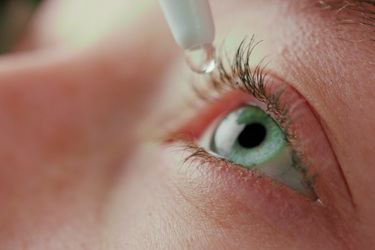Topical Biologics In Ophthalmology?

By Matthew Pillar, Editor, Bioprocess Online

Therapeutic advances excite different people for different reasons. Investors get fired up for cheap production and lucrative markets, with little regard to tech or modality as long as it’s efficient. Researchers tend to geek out a bit more on the tech and science. The lines between biologic and small molecule camps are often pretty distinct. Regulators, of course, don’t get excited about anything, but they do nod affirmatively when safety objectives are met. Patients get excited about real world results, with little thought given to tech, modality, novelty, and mechanisms of action.
A recent clinical study of an eyedrop formulated with Grifols’ Immunoglobulin-based Flebogamma DIF offers cause for optimism among all those stakeholders. It could become the first-approved topically administered biologic therapy for dry eye disease (DED).
Promising Trial Warrants Grifols’ Investment

Selagine is a spin-out company from the University of Illinois at Chicago, where a small Phase1/2 clinical trial comprised of 27 DED sufferers offered some positive initial evidence in favor of immunoglobulin therapy for the condition. Flebogamma DIF eyedrops administered twice daily for eight weeks resulted in a significant reduction in the signs and symptoms of DED, including symptom intensity, corneal staining, and inflammation biomarkers, with no difference in tolerability or adverse events compared to placebo (saline eyedrops). Those results, available in more detail here, were enough for Grifols to up the ante.
“Selagine’s pre-clinical and clinical work, in conjunction with our expertise in research and manufacturing of immunoglobulins, lent naturally to a discussion about partnership,” says Cerezo. “We’ll provide our expertise in manufacturing, drug development, and the regulatory environment. Selagine will bring research, medical, and clinical practice expertise to the table, led by CEO Sandeep Jain, M.D. He's an academic, but he's also a practicing physician who’s recognized worldwide as a corneal expert.”
In fact, it was preclinical research led by Dr. Jain that laid the groundwork for the Flebogamma DIF in-human trial. Jain’s team identified several ocular surface biomarkers that characterized the cohort and designed the subsequent study.
First-Of-Its-Kind Topical Antibody
Immunoglobulins are at the center of Grifols’ wheelhouse. The company has some ophthalmology experience gained through its subsidiary Alkahest, which is working on a handful of ophthalmological candidates. But what’s new to all involved is the potential to create the first topically-applied biologic – a human IgG therapy – in an ophthalmological condition.
Many factors contribute to DED. Proteins (cytokines and chemokines), cells (neutrophils, T-cells and dendritic cells) and pathogenic antibodies are present on the ocular surface in DED patients, all of which contribute to the condition’s symptoms. Selagine’s research findings point to Flebogamma DIF’s broad-spectrum of anti-inflammatory action on the ocular surface as its differentiator. Currently approved therapies are more limited in scope, mainly targeting the T-cell inflammatory mechanism.
Turnkey Manufacturing Infrastructure
With the development partnership in place, Grifols will fund the entire clinical development program through approval by the FDA, and the companies will share clinical, manufacturing, and regulatory project management activities. Grifols would sub-license the potential treatment and make tiered royalty payments based on net sales as well as milestone payments upon achievement of certain annual sales thresholds. But, there’s a lot of work to be done before those milestones are met. Cerezo says the companies are now in the process of mapping their approach to solid clinical development and regulatory plans, in conjunction with optimization of the manufacturing process. “In this particular case, we need to determine how we’ll transform the traditional intravenous and subcutaneously-injected formulations of Flebogamma DIF into a topical solution,” he says. “That's totally doable, but there's some work that needs to be done from the stability and manufacturing perspectives. Then, we’ll establish our full clinical development program and initiate interactions with the regulatory agencies,” he says.
It's likely that continued clinical development and manufacturing activity will take place in-house, leveraging Grifols’ manufacturing infrastructure and IgG domain expertise. “We maintain control of every step of the manufacturing process, from the collection of plasma at our own donor centers, through development and manufacturing, and into the market with finished products.,” says Cerezo.
Large Patient Population Awaits
Cerezo says the ultimate goal of the partnership is to have a topically-administered, biologic eyedrop for DED approved and in patients’ hands by 2030. An estimated 100 million people worldwide, and around 20 million in the U.S. alone, suffer from DED. Current standards of care are slow to affect the condition and require aggressive dosing regimens, requiring up to 4X daily application in some instances, often limited to a reduction in inflammation caused by T-cells, and taking more than a month to affect improvement. Grifols believes its candidate will demonstrate a much quicker onset of action, and it’s initially aiming for a twice-daily application. It also believes its broad spectrum anti inflammatory properties will enable it to more effectively serve more patients. “Dr. Jain has told us that around a third of the patients who visit an ophthalmology clinic exhibit dry eye disease symptoms,” says Cerezo. This condition is more prevalent among women, smokers, and in populations that live in high-wind, low-humidity environments. Complex, multi-factor pathogenesis requires a multi-factor therapeutic effort, which contributes to Grifols’ confidence in its broad-spectrum IgG approach.
“This would be the first topical immunoglobulin for the treatment of a severe, prevalent, and very uncomfortable condition that has a tremendous negative impact on quality of life,” says Cerezo. “From the pharmaceutical perspective, we tend to focus on science and timelines and clinical results. But as a doctor, I always think about improving the patient’s quality of life,” he says. And while he has no desire to go back to bedside care, he is quick to point out that his clinical practice experience informs his career in the pharmaceutical industry. “The experience we have in the clinic—the understanding of what patients need, how they talk, how they speak, and what they request—that’s not something you learn in a book.” In addition to the knowledge of science, those interactions with patients and health systems, he says, bring a lot to the equation as a drug developer. Now, working in lockstep with a practicing world expert in corneal research on a first-of-its-kind novel therapy, Cerezo is relishing the opportunity to directly impact patients once again.
